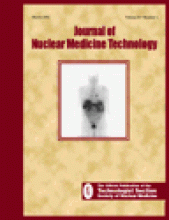
This is the fifth issue in my tenure as editor of JNMT. As I look at the content, this issue has a greater emphasis on tumor imaging than the same issue a year ago. We have a continuing education article about the use of 18F-FDG in tumor imaging, an article about techniques used to make sentinal node images easier to interpret with the addition of a transmission scan to provide anatomical information, and a case report that details potential problems posed when injecting patients for lymposcintigrapy. My reaction to this greater emphasis is that we have really had a major shift in nuclear medicine to tumor imaging. But if I look back 25 years, I see that we were doing a lot of tumor imaging, but with pharmaceuticals that often provided results that were less sensitive and specific. At that time, the work-up for patients with cancer often included a brain scan with 99mTc-glucoheptonate, a liver scan using 99mTc-sulfur colloid, and a bone scan using 99mTc-MDP. Imaging techniques were planar because clinical SPECT imaging was in its infancy. Only one of these tests, the bone scan, is still in routine use. As CT became more prevalent and clinicians found that only the bone scan continued to provide useful clinical information, the other tests became obsolete and are rarely, if ever, performed today.
Today we have very different tools. The continuing education article this month details the application of PET using FDG in oncology patients. Here again, we have a sensitive tool for the detection of cancer. It is interesting to reflect that PET and FDG were certainly around 22 years ago when everyone was worrying that CT would be dominant over the nuclear medicine field. It would be 10 years before someone thought of using FDG PET for the detection of cancer, and 10 more years before reimbursement was available, and then for only a limited number of applications. Still, these events have brought new optimism about the future of nuclear medicine.
Now, many hospitals are trying to determine how they will provide PET scans for their patients, where they will get FDG, how they will find technologists with experience in PET, and where they can find training for their technologists when they cannot hire a technologist experienced in PET. Some of these concerns are easily addressed: FDG is now commercially available, and there are many options for PET scanners. But the one question that is not easily answered is, Where do we find technologists? This is becoming a real crisis for many nuclear medicine departments. Business is growing, but the number of people available to do the work is shrinking.
I have a friend who used to say that the development of new instrumentation and pharmaceuticals in nuclear medicine “leap frog” each other. You get an instrument that has improved resolution or performs a certain task better than what you had previously, and it will sit unused until you have a radiopharmaceutical that allows you to take advantage of the improved instrumentation. This in turn will spur further development in instrumentation. We certainly have seen this in PET imaging. The commercial availability of FDG has definitely helped spur the further development of PET scanners. And we have seen this in other applications in nuclear medicine as well.
I used to think this was also true for the supply of nuclear medicine technologists. When I started in nuclear medicine in the late 1970s, there were many schools for training and ample job opportunities. Salaries increased greatly within very short periods of time. Later, when there were enough technologists, it was no longer so easy for new technologists to find employment, and schools of nuclear medicine technology began closing at a rapid rate. I do not remember how many times we have gone through this cycle in my career, but I am fairly certain it has been at least twice. I think the difference this time is that the number of students entering nuclear medicine technology programs does not appear to be increasing significantly. This low enrollment, coupled with the fact that technologists often move on to jobs in other areas, such as hospital administration or in the private sector, could prolong the shortage of technologists.
The question is, How are we going to staff nuclear medicine departments as we enter this challenging time? We have exciting new technology and are experiencing a revitalization in nuclear medicine, but we have an inadequate supply of technologists. I hope this is one instance where the old adage “the more things change, the more they stay the same” is not true. We as a group need to find ways to get more people interested in nuclear medicine technology. The shortage affects all aspects of our profession: clinical operations, participation in professional activities of the Society of Nuclear Medicine, and even JNMT. People working in departments that are understaffed do not have time to participate in professional activities and enrichment. I am very interested in hearing your ideas as to how we can address this shortage. It is time for a new approach to solving these problems.







